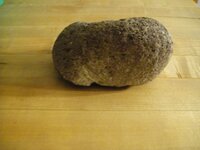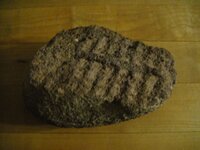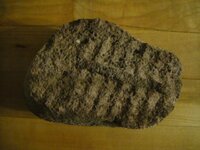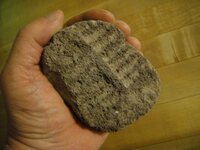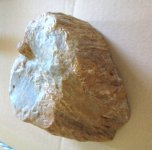unclemac
Gold Member
- Oct 12, 2011
- 7,024
- 6,920
- Primary Interest:
- Beach & Shallow Water Hunting
so about once a year I traipse down to my cousins ranch in NV and poke around her place in the desert in the 95 degree sun. It is always a hoot and this year like the others I find (and often leave) bunches of interesting things. Most of the things I find are pretty common and easy to identify but this one leaves me scratching my head.
Now you got to understand, this part of the desert is in the heart of Paiute country and pretty far from reliable year round water so any habitation would be spring or fall when the dry springs are running and water can be dug in pockets of the seasonal streams. Lots of shelter under the centuries old junipers, shade, game etc. but a real poverty of any material goods not directly associated with daily survival.
This rock is a loose grained basalt to 100% not any sort of fossil. The type and size of rock is as common on the desert floor as needles on a pine tree...there is nothing remarkable about the size, shape or type of stone. It was found with the carved side facing down under a juniper and was only spotted by accident when it was disturbed unintentionally. It doesn't fit in the hand particularly well and if it was meant to be held and used a thousand other nearby stones would have been better choices.
It is 100% man made, doesn't seem to have a function and "perhaps" was placed so as not to be noticed...any ideas or similar artifacts?
Now you got to understand, this part of the desert is in the heart of Paiute country and pretty far from reliable year round water so any habitation would be spring or fall when the dry springs are running and water can be dug in pockets of the seasonal streams. Lots of shelter under the centuries old junipers, shade, game etc. but a real poverty of any material goods not directly associated with daily survival.
This rock is a loose grained basalt to 100% not any sort of fossil. The type and size of rock is as common on the desert floor as needles on a pine tree...there is nothing remarkable about the size, shape or type of stone. It was found with the carved side facing down under a juniper and was only spotted by accident when it was disturbed unintentionally. It doesn't fit in the hand particularly well and if it was meant to be held and used a thousand other nearby stones would have been better choices.
It is 100% man made, doesn't seem to have a function and "perhaps" was placed so as not to be noticed...any ideas or similar artifacts?
Attachments
Upvote
0


